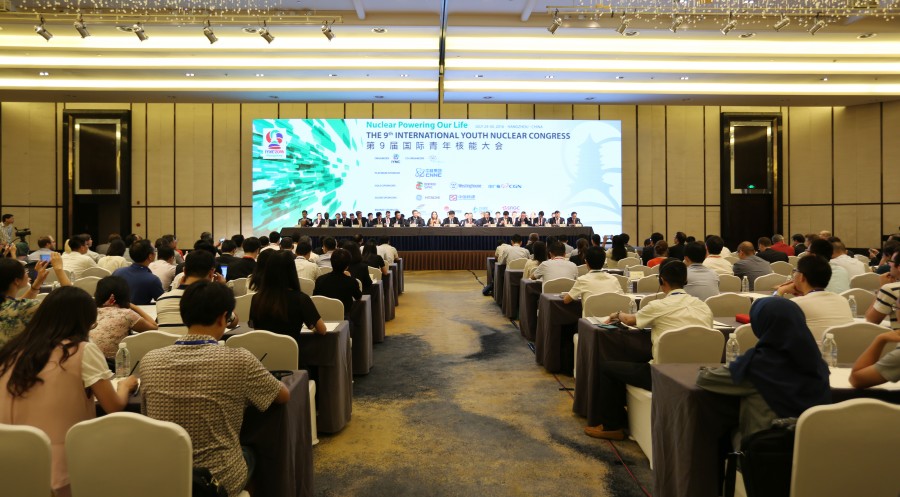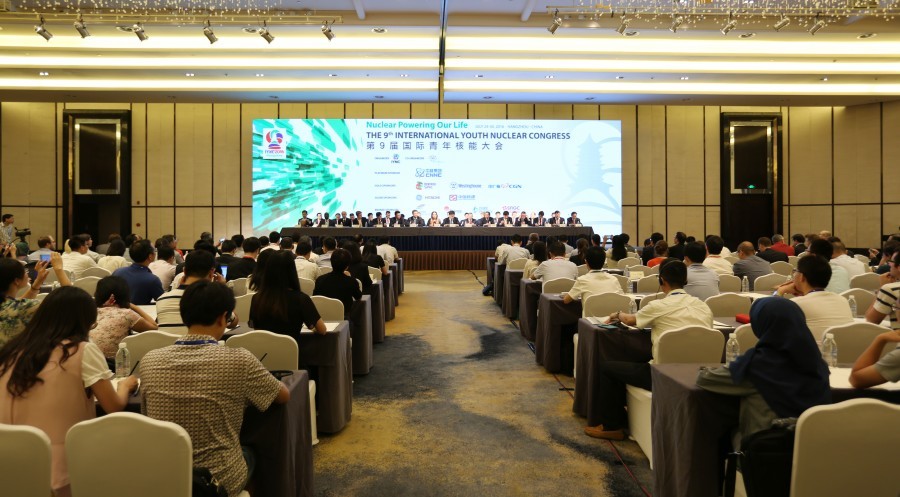
The International Atomic Energy Agency (IAEA) demonstrated their support to the young professionals in nuclear science and technology during the opening session of the 9th International Youth Nuclear Congress in Hangzhou, China. IAEA Director General Yukiya Amano sent a written statement that was delivered during a speech by Mr Dazhu Yang, Deputy Director General and Head of the Department of Technical Cooperation at the IAEA. Approximately 500 participants from 32 countries were in attendance. Read below to see their message to the current and future leaders in the global nuclear sector.
The IYNC mission to promote further peaceful uses of nuclear science and technology for the welfare of mankind is in alignment with the IAEA mandate of Atoms for Peace and Development. IYNC looks forward to future collaborations together with the agency to promote our common goals and is thankful for their support at IYNC2016.
International Youth Nuclear Congress, Hangzhou, China
Opening Session, 25 July 2016
Statement by Mr Dazhu Yang, Deputy Director General and Head of the
Department of Technical Cooperation, International Atomic Energy Agency
Good morning, distinguished delegates, ladies and gentlemen,
I am delighted to join you here today at the opening session of the International Youth Nuclear Congress, in the historic and beautiful city of Hangzhou, China. Before I begin my statement, I would like to convey a message from Mr Yukiya Amano, Director General of the IAEA, who was unable to attend this event due to other engagements. Mr Amano says:
“I send my warmest greetings to you on the occasion of the opening of the 2016 International Youth Nuclear Congress. In my role as Director General of the International Atomic Energy Agency, I have had the opportunity to speak to many young nuclear professionals, and I have been consistently impressed by their energy and enthusiasm. Imagination and enthusiasm are vitally important in the nuclear field — along with a high degree of technical competence.
Nuclear science and technology is an exciting and rewarding field. It enables you to contribute to the well-being and prosperity of your own countries, and of the whole world. The IAEA’s primary objective is to bring the benefits of nuclear science and technology to all humankind, while minimizing the associated risks. This Congress examines many of the fields where nuclear science and technology makes a real difference to people’s lives. I am sure that you will find this Congress inspiring. As young nuclear professionals, you will see some very exciting technological innovations during your careers — for example new generations of nuclear power reactors which will be safer and generate less waste, and new forms of medical imaging that will improve cancer diagnosis and treatment. You may be responsible for some of those innovations yourself. I wish you all every success at this Congress and in your future careers.” End of quote.
Ladies and gentlemen,
The history of nuclear energy is still quite short, but its progress has been very rapid. Ionising radiation was discovered in 1895 by Wilhelm Roentgen. In fact, Roentgen took the first ever X ray image that same year, an image of his wife’s hand. There was immediate scientific recognition of the value of X rays— within a year a radiology department was already opened at the Glasgow Royal Infirmary. Mr Roentgen opened the door for nuclear discovery and for that he received the first Nobel Prize in Physics in 1901.
The first nuclear reactor was built at the University of Chicago in 1942, and the first self-sustaining nuclear chain reaction was initiated on December 2 that year.1 In 1954, in former Soviet Union, a nuclear power plant was connected to the power grid for the first time, with an output of 5 MW. The world’s first commercial nuclear power station, Calder Hall of UK, was opened 60 years ago in 1956 with an initial capacity of 50.
MW.2
Today, there are 446 nuclear power reactors in operation in 30 countries, and a further 63 are under construction. Five power reactors have connected to the grid in 2016: three here in China, one in the Republic of Korea and one in the USA. Here in China, 34 nuclear power plants are operational, and a further 21 are under construction.
Ladies and gentlemen,
The International Atomic Energy Agency was established in Vienna in 1957, as an autonomous organization associated with the United Nations system. I am sure that the IAEA’s name is familiar to you all. The IAEA is often described as the UN’s nuclear watchdog, and it plays an essential role in ensuring that nuclear technology is not misused. But this is not all it does. Development activities have always formed part of our work. The IAEA Statute founded the organization on three pillars: nuclear verification; nuclear safety and security; and the transfer of nuclear technology. These three pillars are still at the heart of the organization’s work.
Article II of the Statute establishes the Agency’s mandate for technical cooperation. It states “The Agency shall seek to accelerate and enlarge the contribution of atomic energy to peace, health and prosperity throughout the world.”
Today, the IAEA has 168 Member States. Of these, around 80% are non-nuclear power States. What draws these countries to join the IAEA? Very often, it is the support we offer for technology transfer through our technical cooperation programme. Today, radiation technology is everywhere in our lives, in fields as diverse as agriculture, industry, medicine and energy. Countries are eager to take advantage of the benefits of nuclear energy, and the IAEA is designed to help them to achieve this goal.
We have been supporting cooperation with Member States for about six decades. We strengthen links between science and development, and build and reinforce scientific networks. Back in the 1950s, the IAEA’s ‘technical assistance’ programme was modest. It consisted of small, short-lived projects that focused mainly on building human resource capacity and creating institutions and facilities that would support the safe and effective introduction of nuclear technology. Today, however, the IAEA focuses on cooperation for sustainable socioeconomic development. We build on the skills and infrastructure that countries have acquired through working with us over the past six decades. Our Member States are full partners in today’s technical cooperation programme, setting national and regional priorities, and offering training opportunities and technical support to the IAEA and to other IAEA Member States. Regional centres of excellence share the benefits of nuclear science and technology among countries.
I’d like to point out the shift from technical assistance to technical cooperation — it shows how sustained development support in a specialised field at the national and regional level, successfully applied over decades, has resulted in a body of countries with solid, institutionalised capacities in nuclear science and technology. As national scientific capacity increases, so too does national ability to take the lead in defining country needs. Scaling up, these capacities allow countries to participate actively — to share resources and expertise — in multi-country projects that address the needs of several Member States.
Development activities have always formed part of the IAEA’s work. While the IAEA is not the lead organization in health, food, environment or water, nuclear science and technology provide essential input to each of these topic areas. Thematic areas covered include human health, agricultural productivity and food security, water resource management, environmental protection, the physical and chemical applications of radiation and radioisotopes, and sustainable energy development. And of course safety is a consistent element throughout the IAEA’s entire technical cooperation programme.
Ladies and gentlemen,
Agenda 2030 and the Sustainable Development Goals reflect IAEA Member States’ national developmental priorities. They will have a significant pact on the future direction of the TC programme. One very important strategy for achieving the new development agenda, as reflected in goal 17 of the SDGs (‘Strengthen the means of implementation and revitalize the Global Partnership for Sustainable Development’), is to mobilize science and technology directed to sustainable development. The IAEA, through its technical cooperation programme and its coordinated research projects, helps Member States to apply nuclear science and technology for the good of humankind. Working together, the IAEA and its Member States can address pressing development needs, producing concrete benefits for the public good, reaching the sick in hospitals, the farmer in the field, families as they go about their daily lives.
Ladies and gentlemen,
The history of nuclear science and technology is full of auspicious names: Roentgen, Curie, Bequerel, Bohr, Fermi… I name only a few. Someday, you may add your own names to this illustrious list. You may be the designer of the first commercial fusion power plant, or a renowned radiation oncologist, saving the lives of cancer patients. You may hold a senior position in your country’s regulatory authority and make a key contribution to radiation safety. You are the face of the future of nuclear science and technology which contribute to peace, health and prosperity around the world. You are the ambassadors of science, limited only by your imagination. I wish you every success in all your future endeavours.
I thank you.


